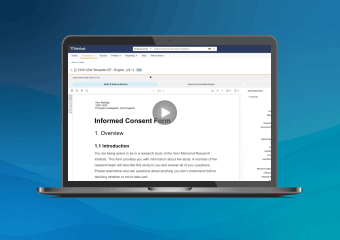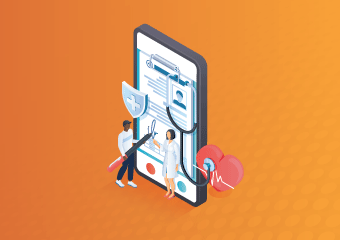Digital Consent Empowers Patients at the Crofoot Clinic

Moving from paper to digital processes allows more patients to participate in clinical trials. It also ensures that they are truly informed as it frees research staff to focus on their care.
The COVID-19 pandemic forced the adoption of digital healthcare technologies, but clinical research documentation has remained in a time warp. “When I started practicing medicine in the late 1970s, there were no cell phones, and I used a 20-MB computer. Medical records were all on paper. Four decades later, to a large extent, they still are. Medical research has not caught up with the rest of the practice of medicine in its use of digital technology,” said Dr. Gordon E Crofoot, who heads up the Crofoot Clinic and Research Center, in a June interview. “Our investigators all use telehealth and other technology to connect with patients, but research hasn’t yet adapted to the new environment,” Charles Sydnor, project manager at the Center, noted in a recent webinar.
The Crofoot Center has pioneered in HIV/AIDS research since the 1980s, when AIDS killed nearly two million people each year. Since its work in the early testing of AZT as a treatment for HIV, the center has participated in more than 130 clinical trials for HIV, as well as Hepatitis B and C. It is now involved in Phase III of the global Mosaico AIDS vaccine trial, sponsored by Janssen Vaccines and Prevention BV. At any one time, the Center’s small, dedicated staff manages between 15 and 20 clinical trials.
Clinical research as a treatment option
For some patients, participation in clinical studies may be their best — or only — chance to access treatments. Dr. Crofoot began to focus on research after he realized that he needed to go beyond palliative care in treating patients with AIDS, then a devastating, poorly understood disease. “To be on the cutting edge of treating this new disease, I had to do research to make treatment and therapies available to my patients,” he said.
He sees digital technologies improving connections between individual physicians in private practices and centers for clinical research, a connection that can also help sponsors with recruitment. Improved and digitized data and document management can only help the overall research effort, so that patients — particularly those from underserved communities — can participate in more clinical studies, he said. In 2021, the Crofoot Center became the first clinical research center in the world to digitally consent a patient using Veeva’s new technology, which connects sites and patients in one system.
Removing the paper burden

Currently, for most clinical research sites, paper-based processes make the business of medical research difficult for investigators and support staff, Dr. Crofoot said. “If I’m doing research and need a document, I have to go through thousands of charts to get the information I need. If I’m travelling, that hunt for documentation must wait until I’m back on site. Meanwhile, my staff spends hours handling signatures, filing and storing paper documents in a system that will make them accessible in case regulators need to see them,” he said.
In the end, however, patients bear the heaviest burden, he said. With paper-based systems, those who volunteer to participate in a clinical trial must take time off from work to come into the office to review and sign papers that give their consent to participate. They may feel pressured to sign the documents quickly to avoid an on-site follow-up visit, and not have sufficient time to review them in depth or discuss them with family members. “Many patients are uninsured or underinsured and don’t have cars. Before COVID-19 made telehealth available to them, they would have to take a long bus trip just to get to the clinic,” Dr. Crofoot said.
In a city like Houston, whose metropolitan area stretches out for about 600 square miles, logistics can prevent potential study candidates from even considering a clinical trial. “If we’re not located along a major bus route, participation won’t even be an option,” said Sydnor.
Increasing trial and consent form, complexity
In an already challenging documentation environment, managing patient consent forms has become a major bottleneck. As clinical protocols become more complex, the challenges are only increasing. Studies often end up with multiple versions of consent, therefore it can be difficult for sites to be certain they are giving the right version to the patient at the right time. Furthermore, some forms may include extra questions for additional consents, e.g. biopsies or sample storage, which lead to additional data management challenges for paper based processes.
In addition, sponsors are using several eConsent forms, but they are all customized and cannot be integrated with the site’s own data management systems. This has resulted in a situation where clinical staffers must use one tool for one study and a different tool for another, and then track data for all of them. Having a solution that isn’t integrated into the rest of the workflow only increases work and compliance risks,” said Anna Argyris, director of Veeva Site Solutions. For the past few years, both the European Medicine Agency and the US FDA have singled patient consent management as a problem area that can trigger audits and deeper scrutiny of individual clinical trials.
Paper processes also limit sites’ visibility across each study or all studies at any one time. “As our staff began to move beyond outpatient clinics and into patients’ homes, we could never be sure that they weren’t using an older version of the signed consent. For high-volume trials, multiply one consent form by hundreds of patients and all the re-consent documentation that sponsors may be sending out. It’s costly and difficult to manage and you never know what might happen to that paper binder when you step away on vacation,” said Sydnor.
Complex workflows

For clinical support staff, Sydnor said, there is a constant back and forth of checking consent forms, making sure versions are all correct and signed. Each of these steps steals minutes that could be better used, as three or four people focus on file pulling, hole punching, and placing documents into paper file folders, he said.
Workflows are also time-consuming, involving a significant amount of telephone contact. The traditional administrative workflow for a clinical trial starts with the handoff from the investigator. Administrative staff then call to set up an appointment for the patient to come to the Center, in person, to ask questions and give consent. This approach put a lot of pressure on potential participants, as well as staff, said Sydnor.
“You want to allow the patient to have as much time as possible to make their decisions. You want to answer all their questions and allow them to talk to their own support system at home to make that choice. When you have a patient come into our practice, they are under pressure — whether or not they verbalize it — to avoid having to return to our center for additional questions during a follow up meeting. Next is the screening visit, typically scheduled on a different day from the consent process, requiring, for some patients, another long bus trip and time away from work and their lives.
“Lately, some sponsors have been updating protocols, resulting in a rapid succession of new consent forms from sponsors. Patients might want to review previous forms and compare them to the new forms, to be prepared with good questions when they meet the investigators. If a second visit is to be avoided, staff will then have to find the old consent forms and send them to the patient. In some cases, ensuring that patients fully understand what they are signing can require enlarging type sizes, which takes time,” said Sydnor.
Benefits of integration
The Crofoot Center’s adoption of Veeva’s system has eliminated the need to file and update paper consent forms as well as logs. Patients have access to their consent forms as well as other documentation. “Having a flexible electronic consent puts control in the patients’ hands, and allows each subject’s consent to be truly informed,“ said Sydnor. Investigators can confirm potential study subjects without leaving their homes.
At first, the prospect of adopting new technology was scary, Sydnor says, but the system has saved the Center significant time and money. “It has allowed us to get back to doing what we want to focus on: taking care of patients, getting that joy from our interactions with them, and seeing the benefit of their participation. In the end, that’s what we’re all here for,” he said.
To learn more about Veeva eConsent for your site, click here.
Author: Tim Davis, VP of Strategy, MyVeeva for Patients
Want exclusive tips and resources?
Be the first to recive upcoming news, join our mailing list.
Subscribe


